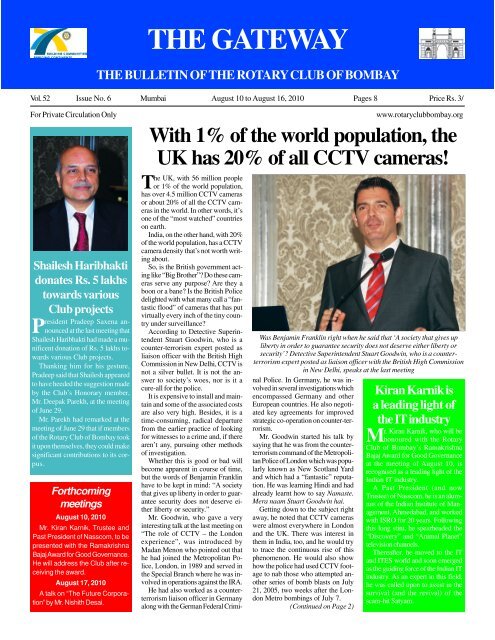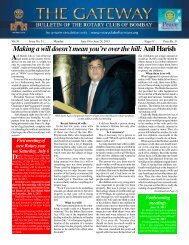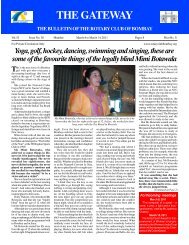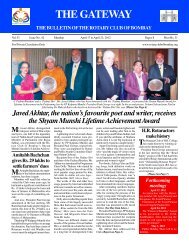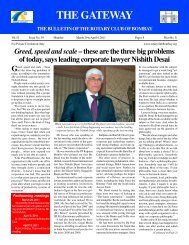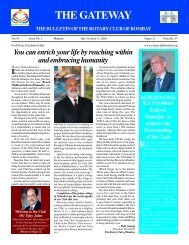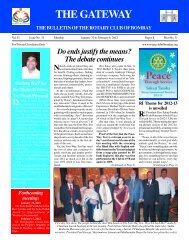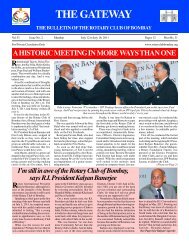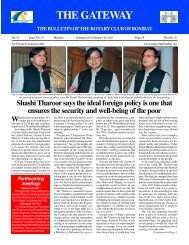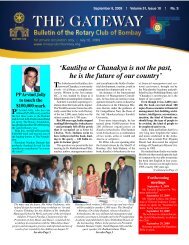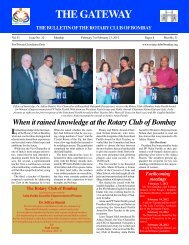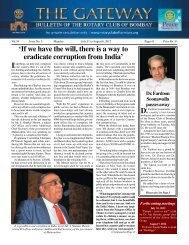Create successful ePaper yourself
Turn your PDF publications into a flip-book with our unique Google optimized e-Paper software.
THE GATEWAYTHE BULLETIN OF THE ROTARY CLUB OF BOMBAYVol. 52 Issue No. 6 Mumbai August 10 to August 16, 2010 Pages 8 Price Rs. 3/For Private Circulation OnlyShailesh Haribhaktidonates Rs. 5 lakhstowards various<strong>Club</strong> projectsPresident Pradeep Saxena announcedat the last meeting thatShailesh Haribhakti had made a munificentdonation of Rs. 5 lakhs towardsvarious <strong>Club</strong> projects.Thanking him for his gesture,Pradeep said that Shailesh appearedto have heeded the suggestion madeby the <strong>Club</strong>’s Honorary member,Mr. Deepak Parekh, at the meetingof June 29.Mr. Parekh had remarked at themeeting of June 29 that if membersof the <strong>Rotary</strong> <strong>Club</strong> of <strong>Bombay</strong> tookit upon themselves, they could makesignificant contributions to its corpus.ForthcomingmeetingsAugust 10, 2010Mr. Kiran Karnik, Trustee andPast President of Nasscom, to bepresented with the RamakrishnaBajaj Award for Good Governance.He will address the <strong>Club</strong> after receivingthe award.August 17, 2010A talk on “The Future Corporation”by Mr. Nishith Desai.The UK, with 56 million peopleor 1% of the world population,has over 4.5 million CCTV camerasor about 20% of all the CCTV camerasin the world. In other words, it’sone of the “most watched” countrieson earth.India, on the other hand, with 20%of the world population, has a CCTVcamera density that’s not worth writingabout.So, is the British government actinglike “Big Brother”? Do these camerasserve any purpose? Are they aboon or a bane? Is the British Policedelighted with what many call a “fantasticflood” of cameras that has putvirtually every inch of the tiny countryunder surveillance?According to Detective SuperintendentStuart Goodwin, who is acounter-terrorism expert posted asliaison officer with the British HighCommission in New Delhi, CCTV isnot a silver bullet. It is not the answerto society’s woes, nor is it acure-all for the police.It is expensive to install and maintainand some of the associated costsare also very high. Besides, it is atime-consuming, radical departurefrom the earlier practice of lookingfor witnesses to a crime and, if therearen’t any, pursuing other methodsof investigation.Whether this is good or bad willbecome apparent in course of time,but the words of Benjamin Franklinhave to be kept in mind: “A societythat gives up liberty in order to guaranteesecurity does not deserve eitherliberty or security.”Mr. Goodwin, who gave a veryinteresting talk at the last meeting on“The role of CCTV – the Londonexperience”, was introduced byMadan Menon who pointed out thathe had joined the Metropolitan Police,London, in 1989 and served inthe Special Branch where he was involvedin operations against the IRA.He had also worked as a counterterrorismliaison officer in Germanyalong with the German Federal Crimi-www.rotaryclubbombay.orgWith 1% of the world population, theUK has 20% of all CCTV cameras!Was Benjamin Franklin right when he said that ‘A society that gives upliberty in order to guarantee security does not deserve either liberty orsecurity’? Detective Superintendent Stuart Goodwin, who is a counterterrorismexpert posted as liaison officer with the British High Commissionin New Delhi, speaks at the last meetingnal Police. In Germany, he was involvedin several investigations whichencompassed Germany and otherEuropean countries. He also negotiatedkey agreements for improvedstrategic co-operation on counter-terrorism.Mr. Goodwin started his talk bysaying that he was from the counterterrorismcommand of the MetropolitanPolice of London which was popularlyknown as New Scotland Yardand which had a “fantastic” reputation.He was learning Hindi and hadalready learnt how to say Namaste.Mera naam Stuart Goodwin hai.Getting down to the subject rightaway, he noted that CCTV cameraswere almost everywhere in Londonand the UK. There was interest inthem in India, too, and he would tryto trace the continuous rise of thisphenomenon. He would also showhow the police had used CCTV footageto nab those who attempted anotherseries of bomb blasts on July21, 2005, two weeks after the LondonMetro bombings of July 7.(Continued on Page 2)Kiran Karnik isa leading light ofthe IT industryMr. Kiran Karnik, who will behonoured with the <strong>Rotary</strong><strong>Club</strong> of <strong>Bombay</strong>’s RamakrishnaBajaj Award for Good Governanceat the meeting of August 10, isrecognised as a leading light of theIndian IT industry.A Past President (and nowTrustee) of Nasscom, he is an alumnusof the Indian Institute of Management,Ahmedabad, and workedwith ISRO for 20 years. Followingthis long stint, he spearheaded the“Discovery” and “Animal Planet”television channels.Thereafter, he moved to the ITand ITES world and soon emergedas the guiding force of the Indian ITindustry. As an expert in this field,he was called upon to assist in thesurvival (and the revival) of thescam-hit Satyam.
Shalom! Welcome to Israel. Ms Orna Sagiv, Honourable Consul-General of Israel, screened a short video promoting her country at the last meeting. Withher are President-Elect Paul George, PP Gul Kripalani and President Pradeep. In the second picture, (Dr.) Indu Shahani at the lunch table with her guestMs Daryl Rand, President of Rand Advertising in New Jersey and who was recently inducted into the ‘Advertising Hall of Fame’, and Nanik RupaniIsrael is as safe as <strong>Bombay</strong>, New York andLondon, assures Consul-GeneralMs Orna Sagiv, the Hon'bleConsul-General of Israel,‘3 Idiots’, anyone?The Committee for Senior Citizenshas arranged a specialscreening of the popular Hindi film 3Idiots for the residents of the Homefor the Aged at Khareghat Colonyon Monday, August 16.According to Chairman NareshKumar Jain, the film will be screenedfrom 3 to 6 pm and the senior citizenswill be provided snacks as theywatch the movie in the comfort oftheir Home.He has invited all members tomake it a point to visit the Home forthe Aged at Khareghat Colony andto enjoy 3 Idiots in the company ofthe senior citizens.Mr. Narayan Sawant, the <strong>Club</strong>’ssocial worker, is coordinating theevent.screened a short video promotingtourism, trade, business and variousother aspects of her country at thelast meeting of the <strong>Club</strong>.Speaking before the showing, shesaid she looked forward to receivingthe group that would take part in thebusiness-cum-pleasure trip to Israeland Jordan being planned by the FellowshipCommittee of the <strong>Rotary</strong><strong>Club</strong> of <strong>Bombay</strong> in association withthe Indian Merchants’ Chamber.Allaying the fears of those whowere worried about their safety inIsrael, Ms Sagiv asserted that Israelwas as safe as <strong>Bombay</strong>, New York,London and Spain.“I know you are going mainly forleisure, but I urge each and every oneof you to use the opportunity to dobusiness, too,” she added.As members are aware, the trip toIsrael and Jordan will take place inNovember-December this year.Fellowship Chairperson ShernazVakil, who has been working in closecoordination with PP Gul Kripalaniand the Indian Merchants’ Chamberin order to make the visit a success,has said that detailed informationabout the trip (from November 23 toDecember 3) has been conveyed tomembers by the <strong>Rotary</strong> Secretariat.The addition of Jordan to the itinerarywas bound to make it evenmore exhilarating, she added.As already reported, a total of 180seats had been booked on an El Alflight which would offer variousclasses of seating to the passengers.Birthday donationsArif Lokhandwalla has made abirthday donation of Rs. 10,000.Similarly, <strong>Rotary</strong>ann Padma Lal hascontributed a sum of Rs. 1,001. PresidentPradeep thanked both membersfor their generous donations.At the last meeting(Held on August 3, 2010)PRESIDENT Pradeep Saxenacalled the meeting to order andwelcomed the guest speaker, theHonorary Consul-General of Israel,Ms Orna Sagiv, Ms Daryl Rand,President of Rand Advertising inNew Jersey and who was recentlyinducted in the “Advertising Hall ofFame”, the Visiting Rotarians,<strong>Rotary</strong>anns, guests and others.BIRTHDAYSMembers and spouses celebratingtheir birthday during the weekwere felicitated.ATTENDANCEMembers 137Visiting Rotarians 3Spouses/<strong>Rotary</strong>anns 8Guests 7Total 155Svc. box collection Rs. 3,700Good to see that you are as fit as ever and back in business. Rajas Doshi chats with IPP Nandan Damani. In the second photograph, President-Elect PaulGeorge greets First Lady Sunita Saxena who celebrated her birthday on August 9August 10 to August 16, 2010 THE GATEWAY, The Bulletin of the <strong>Rotary</strong> <strong>Club</strong> of <strong>Bombay</strong> Page 3
Ananimationfilm forsomedifferentlyabledchildrenIt’s going to be a lovely film. Children at the S.E.C. Municipal School await the screening of the animation film ‘BalThe Committee for the DifferentlyAbled, which is Chaired byHanuman’. Thank you for arranging the film, a differently abled child tells President Pradeep at rightPP Kalpana Munshi, organised thescreening of the popular animationfilm Bal Hanuman at the S.E.C.Municipal School on Wednesday,July 28.Over 100 children facing differentchallenges – most of them aged between5 and 12 years – watched thefilm with rapt attention.Giving them company were PresidentPradeep Saxena, Kalpana, AshokJatia, <strong>Rotary</strong>ann Zarine Chothia,Shyyamniwas Somani, NareshKumar Jain and Sudha Malhotra.Also present were several youngRotaractors who have alwaysstepped forward to lend a helpinghand in the various programmes andprojects of the <strong>Rotary</strong> <strong>Club</strong> of<strong>Bombay</strong>.The programme featuring the filmThere’s hardly any aeration in these drinks. Ashok Jatia presents popcorn and other items to the children. At right, Zarine show was the result of the effortsChothia, Ashok, Pradeep, Shyyamniwas, Naresh Jain, PP Kalpana Munshi and Sudha Malhotra with the children put in by Committee Co-ChairmanAshok Jatia and Committee memberZarine. They arranged candyfloss,popcorn, cakes, pastry and softdrinks for all the children so that theyenjoyed the rather rare experience ofwatching a film.Kalpana promised the childrenthat very soon a park along with awell-equipped playground would bemade available for their recreation.While President Pradeep spokewarm words of affection and encouragement,Sudha Malhotra happilytook the mike and rendered the popularsong Hum honge kaamyaab in hermelodious voice.Kalpana reports that the Committeehas arranged a series of projectsfor the rest of the year and has appealedto her fellow members to attendthese programmes to enjoy atNo, I’m not going to give you a speech. Pradeep offers warmth and affection to the children. At right, Sudhafirst hand the joy of sharing someMalhotra sings ‘Hum honge kaamyaab’ in her melodious voice and gets the children to sing along with hermoments of happiness with the lessfortunate sections of society.August 10 to August 16, 2010 THE GATEWAY, The Bulletin of the <strong>Rotary</strong> <strong>Club</strong> of <strong>Bombay</strong> Page 4
Rotaractors of H.R. College hold a celebration as the<strong>Club</strong> enters its Silver Jubilee YearThe Rotaract <strong>Club</strong> of H.R. Collegehas entered the 25th year of serviceto the community.At the meeting of July 13, the Principalof the College, (Dr.) Indu Shahani,presented a silver salver as a mementoto President Pradeep Saxena to thankthe <strong>Rotary</strong> <strong>Club</strong> of <strong>Bombay</strong> for its help,support and guidance over nearly aquarter of a century.A few days before that, on July 9,the Rotaractors organised a grand eventwhich featured dances, short plays,skits, videos, awards and other entertainingitems before an audience of over400 people.The programme was called “AchievingMilestones” – the theme for the<strong>Club</strong>’s 24th year – and was held in theK.C. College Auditorium next door.(Dr.) Indu was the guest of honour andgave an inspiring talk to the young, enthusiasticgathering.Suveer Bajaj, a former student, actedas the master of ceremonies and tookthe audience on a walk down memorylane, recalling several significant happeningsand milestones from the richhistory of the Rotaract <strong>Club</strong> of H.R.College.One interesting video presentationwas followed by another. The inspirational“Milestones Achieved” videocame before the one that looked back atthe first few years of the <strong>Club</strong>, from1986 to 1995.And, wonder of wonders, CharterPresident Ritu Chaudhri turnedup to attend the programme. Shetalked about her experiences andthe difficulties of the first few formativeyears. She recalled receivinga great deal of help from thethen President, Arjun Bulchandani,and from Deepak Kapadia who hadhelped establish the <strong>Club</strong>.Videos depicting the next two stagesof the <strong>Club</strong>, from 1996 to 2005 andthen from 2006 to 2010, were alsoplayed. While PP Navin Chawla talkedabout the activities of the first of thesetwo stages, PP Yashraj Jain spoke aboutthe activities between 2006 and 2010.To break the monotony, there weredances, plays, skits and other performancesby present and former membersof the <strong>Club</strong>, as also from non-membersand outsiders, which had the audiencecheering and applauding lustily.Six former alumni, who had contributedto the <strong>Club</strong>’s activities even afterthey had ceased to be members, werepresented with mementoes. And everyPast President who had served the<strong>Club</strong> and was present at the programmealso received a memento.Special citations were presented torepresentatives of District 3140, the<strong>Rotary</strong> <strong>Club</strong> of <strong>Bombay</strong> and H.R. Collegefor their ceaseless nurturing andsupport of the Rotaract <strong>Club</strong> of H.R.College.Interestingly, citations were presentedto the teaching and the nonteachingstaff – including the peons –of H.R. College.The Principal, (Dr.) Indu Shahani,made a brief speech on the occasionwhen she lauded the successive <strong>Of</strong>fice-Bearers for taking the <strong>Club</strong> to unprecedentedheights and making it the bestRotaract <strong>Club</strong> in the city of <strong>Bombay</strong>.A cheque for Rs. 2.50 lakhs – representingthe collections from the PankajUdhas Nite held on May 28 – wasgiven to the Parents’ AssociationThalassaemic Unit Trust (PATUT) asa donation. With this, the H.R.Rotaractors had donated a total of Rs.20.5 lakhs to this trust over the lastseven years.Another memento was presented toMr. Sajjanraj Mehta who had been supportingthe <strong>Club</strong>’s Inter-School AthleticsMeet for intellectually-impairedchildren for the last 15 years.Then it was time to receive the blessingsof President Pradeep Saxena of the<strong>Rotary</strong> <strong>Club</strong> of <strong>Bombay</strong>. He made aninspiring speech that was not devoidof warmth and affection.Also present on the occasion werePP Gul Kripalani and Mehul Sampat,the <strong>Rotary</strong> <strong>Club</strong> Chairman for Rotaract.A sumptuous spread helped dousethe pangs of hunger as the celebrationsto mark the entry of the <strong>Club</strong> into its25th silver jubilee year came to an end.The Rotaractors of H.R. College arepoised on the cusp of a historic datewith destiny. But they have many moremiles to go...Snapshots of the new <strong>Of</strong>fice-Bearers of the Rotaract <strong>Club</strong>of H.R. CollegeYet another set of pictures ofthose who will be hard at workat the RCHRThe installation meeting forthe new team is just roundthe corner, says NihariekaAugust 10 to August 16, 2010 THE GATEWAY, The Bulletin of the <strong>Rotary</strong> <strong>Club</strong> of <strong>Bombay</strong> Page 5
‘NOT ONLY POLICE, EVEN THE PUBLIC BELIEVESTHAT CCTV CAMERAS ARE A VERY POWERFUL TOOL’(Continued from Page 2)India, on the other hand, with 20%of the world population, had a CCTVcamera density that was not worthwriting home about.“But how did a small country likethe UK come to possess so many cameras?It was actually an accident, likemany things that happen in the UK...”The first time that a camera caughtcrime in the course of public spacesurveillance in the UK was in Scotlandin the days of light-sensitivepaper that required hours if not daysto develop a photograph. One picturehad caught someone stealing ahandbag. Things got going only in the1970s.As the consumption of alcoholincreased on Friday and Saturdaynights, there was behaviour of thetype not normally seen in decentLondon with its huge African Caribbeanpopulation.CCTV images taken in Brixton andshown on the news helped nab theman even as he was planting a bomb.The public soon started to believethat CCTVs were quite a powerfultool<strong>Of</strong> course, there were those whohad problems such as people workingfor civil liberties and so on. Butall of them were forced to hold theirfire because the new tool was cominginto vogue at a time when the countrywas dealing with Irish terrorism.“The word terrorism is often usedto stifle public debate – and I wouldsay that as a counter-terrorism officer.Terrorism is an awful thing andno one knows that better than theresidents of Mumbai, but it shouldn’tbe used as something that stifles publicthe cameras that seem to be everywhere.“A lot of it is farmed out to theprivate sector, which again creates aproblem when we try to ‘harvest’ theimages, or to find the cameras, becausethe private sector is not regulated;it goes about changing cameras,moving them or taking them downwithout informing us. Every timesomething happens, we have to goout afresh and identify where thecameras are, who owns them andwhere the images are being stored.”Mr. Goodwin claimed that the generalpublic in the UK was not worriedabout CCTV. It believed that ifone had nothing to hide, then therewas nothing to worry. But the publiconly looked at things in black andwhite; it never mulled over or debatedissues in detail.some inappropriate behaviour, wasgoing on.The authorities had stepped in recentlyand camera operators werenow being regulated. They had tohave a certification in order to dopublic space surveillance.Mr. Goodwin next referred toANPR or Automatic Number PlateRecognition which was being usedwith increasing frequency. It automaticallypicked out the registrationplates on cars and checked themagainst police and other data bases. Ifan agency had any concerns, it couldask the CCTV providers with ANPRto look for certain cars. Although thissystem was invented in 1976, the firstarrest of a person driving a stolen carwas recorded in 1981 in Dartford inKent.And now, after wasting a lot ofsocieties. Such anti-socialdebate about some very serious Since the police did not monitor time, money and energy, the Met-behaviour was becoming a problemin the cities and, when combinedwith other crimes such asthefts from cars, burglaries and soon, someone thought about installingcameras so that the revellerscould be monitored.When the Home <strong>Of</strong>fice made grantsavailable to local authorities to suggestsolutions, they came up withsome very good business cases. Suddenly,CCTV systems financed bythe Home <strong>Of</strong>fice were springing upall over the UK.However, they made an impactonly in 1993 following the murder ofa two-year-old boy, Jamie Bolger,who was with his mother in a shoppingcentre in the north of England.Two ten-year-old boys managed tolead him away when his motherwasn’t paying attention. The CCTVfootage showed one of the boys leadingJamie by the hand out of the shoppingcentre.Mr. Goodwin said that the boyswent on to murder the child on a railwaytrack. The CCTV images wereforced on the public consciousnessand led to the capture and prosecutionof the two boys.There were a few other cases, too,such as that of David Copeland whowas “a loner, a right-wing extremistwho hated everybody who was differentissues.“What many people don’trealise is that of all the cameras,very few are controlled by the policethemselves. Even in the secureareas of London where theseats of governance are located,there are very few cameras monitoredby the police. They are monitoredby private industry and localauthorities... we ourselvesdon’t have the people to monitorthe cameras, it had no control overthem or over the individuals sitting inrooms and monitoring them whileworking for private companies. A recentuniversity study had shown thatsome of these individuals spent theirtime looking at inappropriate things.Those most likely to be zoomedin and filmed were attractive womenand coloured people of both genders.There were some issues involved inthis and some discrimination, as alsoropolitan Police had finally concludedthat if it wanted effectivesystems, it had to get people whoknew what they were doing andwho could devote their energiesto think of solutions and the bestways to implement them. The policehad finally started using privateindustry.“I have here (in the audience) acolleague from the Olive Group (Mr.David Samwell) which records all thetraffic going into London throughANPR systems; it’s an incrediblyeffective tool and was brought in aftera considerable spate of bombingsby the IRA. If the police use industry,then you can really get thingsgoing.“Some of the issues that I talkedabout, about the cameras being everywhereand not being regulated... ifyou use industry properly and givethem a tight brief of what you aretrying to achieve, you can workagainst those issues and make surethat you are using your cameras forthe purpose you have in mind.“We are now sitting down and talkingto the community. We don’t haveall the answers... we tell them thatwe can give you a police state, butwe’re sure you don’t want that. Sowhat are the levels that society willtolerate? We have to find out.”from himself”; he carried out a In spite of the plethora of cameras in the UK, very few are controlled by the Mr. Goodwin then took a light digseries of attacks, in Bricklane in the police themselves. Even in the secure areas of London where the seats of at the traffic situation in <strong>Bombay</strong> andeast end of London (a predominantly governance are located, there are very few cameras monitored by the suggested the introduction of laneAsian area), in a Soho bar for gay police. They are monitored by private industry and local authorities, discipline as in London. “Whypeople and in Brixton in the south ofreveals Mr. Stuart Goodwindoesn’t somebody paint white linesAugust 10 to August 16, 2010 THE GATEWAY, The Bulletin of the <strong>Rotary</strong> <strong>Club</strong> of <strong>Bombay</strong> Page 6
on Mumbai roads? The solutions arethere, but we need mechanisms toimplement them... Perhaps numberplates ANPR can be the answer.”Finally, he turned to the two actsof horrendous terrorism that rockedLondon in the July of 2005 and therole of CCTV first in unravelling theMetro bombings of July 7 and thenin preventing their repetition on July21.When London was hit by four suicidebombers on July 7 that killed 52innocent people, CCTV proved tobe of immense help. Having notedthe spots where the bombs had goneoff, the police worked on the presumptionthat the four suicide bomberswould have been together at somestage before they split up.It was sheer good luck that the firstpresumption turned out to be right.The police guessed that the bomberscould have met at King’s Cross. On amap an area with a radius of two km.around King’s Cross was drawn andtreated as the first priority. A sufficientnumber of people were sent tothis area around King’s Cross to getall the footage and to go through it.Indeed, considering the concentrationof cameras, a very large number ofpeople were required.“But we were right... (We sawon CCTV footage) two young menwith rucksacks, followed by anothertwo... and following themwas this man with a briefcase. Hewill never be able to forget it – heis a Scotland Yard anti-terroristbranch officer and he didn’t noticeanything unusual about thosefour men with rucksacks! Whywould he?“We had a start. We knew thatthey were all together at that spot.So we tried to find out how they gotto King’s Cross. We started lookingbackwards, at the trains that came inat King’s Cross at that time; we thenlooked at the footage from the platforms...and we found them there.Soon, we knew on which trains theyhad come in. And then we were ableto go further back to follow their journeyand to find out the place fromwhere they had travelled.“And that, you may think, is that.But you also need to find out whetherthey are part of a cell, with whomhave they been in contact... and youneed to work quickly. And that’swhere CCTV is a phenomenal tool.We collected a lot of information andin a couple of days we knew wherethey had their bomb factory and wereable to find it.”Mr. Goodwin also screened CCTVfootage of a slip road leading up to aservice station. Even footage frominside the service station was found.It was taken around 5 in the morningand showed one of the bombers. Heknew he was going to blow himselfup, but he stopped to buy somethingto eat.It was a massive investigation andCCTV had proved to be an incrediblypowerful tool.While three of the bombers hadblown themselves up in the Metro,one had gone and detonated his bombin a bus. But had the bus been decidedupon as a target? Or had somethingelse occurred that had forced achange in plans?Once again CCTV cameras came tothe rescue and provided the answer.The fourth bomber had tried to getinto the northern line but it was shutbecause of some problems. Luckily,he had not exploded his bomb on theconcourse, during rush hour at King’sCross.He had the bomb on his back, heknew he wanted to detonate it, buthe just didn’t know what to do.Thanks to the CCTV footage, thepolice were able to see his movementsand also to see whether he wastaking instructions from someone.The CCTV footage showed thisfourth bomber wandering one wayand then another. (This man finallyblew himself up in a bus.)Mr. Goodwin rebutted the criticismthat CCTV only helped detectcrime, not prevent it.“I would say it does, but sometimesyou just don’t know what wehave prevented. The bombers thatstruck London two weeks later intheir attempted attacks is an exampleof how CCTV helped prevent crime.“We had a group which tried tolet off bombs in London but failed.I would put money on the fact thathad we not quickly apprehendedthem, they would have gone onand achieved their mission. Theywould have improved the designof their bombs and carried outtheir bombings.”On July 21, two weeks after theJuly 7 bombings with the whole forcebusy in the investigations, there werea further four attempted bombings.Yet the police managed to obtain allthe CCTV footage and to completethe investigation and to make arrests.In one case, the footage showedone of the bombers in a train attemptingto detonate a bomb in his rucksack.The people around him recoiledas he stood holding the rail and tryingto set off his bomb. Only the detonatorwent off and it was described as aloud thud.The footage showed people recoilingand a man in a white T-shirt whowas an off-duty fireman, remonstratingwith him... The bomber was saying,“No, it wasn’t me...”And then the tube went into a stationand the man escaped. He dumpedhis rucksack which offered a lot offorensic leads and evidence. TheCCTV had also provided a very goodimage.Within 24 hours the police hadimages of all the other bombers. Thesewere released and, because the communityhad confidence in the policeforce, telephone calls started pouringin, including one from the caretakerwho managed the block of flats wherethey were put up.He said they fit the description.They were up to something funnywith chemicals, throwing away plasticcontainers that smelt strongly (“aclassic symptom of hydrogen peroxide”).Although the police had the address,the men had fled – but becauseof CCTV, they were able to trackthem and by July 29 all four bombershad been caught.Some horrible mistakes weremade by the police on July 22,when an innocent man, JeanCharles de Menezes, a Brazilian,was shot dead in the belief that hewas one of the bombers. Unfortunately,this episode overshadowedwhat had actually turned out to bea brilliant piece of detective work.“To have attempted bombings twoweeks after successful bombings inLondon, and to catch people underthose conditions and in that short aspace of time, is simply stunningdetective work, but it wouldn’t havebeen possible without effectiveCCTV and CCTV management,” Mr.Goodwin added.The vote of thanks was proposedby Mehul Sampat.Getting private industry into policing has worked wonders, says Mr. Stuart Goodwin of Scotland Yard. At left is Mr. David Samwell of the OliveGroup, which has been associated with the London Police on counter-terrorism measures. President Pradeep Saxena (at right) presents a memento tothe guest speakerAugust 10 to August 16, 2010 THE GATEWAY, The Bulletin of the <strong>Rotary</strong> <strong>Club</strong> of <strong>Bombay</strong> Page 7
ROTARY CLUB OF BOMBAYFOUNDED 19 MARCH, 1929Charter No. 3128, Dated 08 May, 192997-B, Mittal Tower, Nariman Point,Mumbai 400 021, INDIATel.: +91-22-2202 4089Fax.: +91-22-2202 4509rc_bombay@rediffmail.comOFFICE-BEARERS 2010/11PRESIDENT PRADEEP SAXENAImm. Past President Nandan DamaniPresident-Elect Paul GeorgeVice-President Nowroze VazifdarHonorary Secretary Bipin KapadiaJoint Hon. Secretary Sitaram ShahHon. Treasurer Ishraq ContractorDIRECTORSVineet Bhatnagar Roda BillimoriaSuresh Goklaney Shailesh HaribhaktiShivkumar Israni Arin MasterS.K. Mitra Ramesh NarayanCLUB SERVICE – New MembersDirectorPaul GeorgeClassifications PP Ashish VaidMembership PP Dr. Adi DasturMember. Dev. & DisCon Nowroze VazifdarInformation PP Dr. Kekoo KavaranaMentoring & Assimilation PP Dr. Sandip AgarwallaCLUB SERVICE – Programmes/MeetingsDirectorRamesh NarayanFellowship Shernaz VakilSportsMoy BiswasProgramme Dolly ThakoreSergeant-at-Arms Pradeep GujarathiAttendance Arvind AgarwalBulletin & Website PP Arun SanghiPublic Relations Priyasri PatodiaCOMMUNITY SERVICE – MedicalDirectorArin MasterChairman Emeritus,TalwadaPP Dr. Rahim MuljianiHTEC, Talwada PP Dr. Rumi JehangirADMC, Talwada Dr. Mitul PatelOral Health Dr. Sorab JaveriControl of TB Prof. Rohini ChowguleHepatitis & Polio Immu. Dr.Vandana BulchandaniCancer Aid Zinia LawyerCOMMUNITY SERVICE – Non-MedicalDirectorSuresh GoklaneyRCCShyyamniwas SomaniGlobal Warming/Green Vision Jagdish MalkaniOld Age Homes/Senior Citizens Naresh Kumar JainWomen Empowerment Preeti MehtaRural Development Dilnavaz VariavaWater Management Ramesh DhirVOCATIONAL SERVICEDirectorS.K. Mitra<strong>Rotary</strong> & Public Awards Nelum GidwaniPromotion of Arts,Music & Dance Sabira MerchantFour-Way Test Manojj Kumar PatodiaINTERNATIONAL SERVICEDirectorShailesh HaribhaktiR.I. Programmes PP Rajnikant Reshamwala<strong>Rotary</strong> Foundation/Matching Grants PP Arvind JollyFund-Raising Ashok MinawalaNEW GENERATIONS – EducationDirectorVineet BhatnagarEducation for All Alok Sekhsaria<strong>Rotary</strong> Suraksha Loans Ashok JatiaMerit-cum-MeansScholarships Madhusudan DagaManagement Studies Poonam KumarLegal Case Practice Apurva DiwanjiNEW GENERATIONS – YouthDirectorRoda BillimoriaInteractArjun JollyRotaractMehul SampatNight Study Centres Sunny PariyaramVocational Train.Centres Jacob AbrahamRoad Safety Deepak KapadiaDISTRICT THRUST PROJECTSDirectorShivkumar IsraniDifferently-Abled PP Kalpana MunshiDishaSubash GogiaRural Lighting Kiran NandaAdoption ofPolice Station Nirav ShahRegd. No. MH/MR/South-109/2009-11; R.N.I. No. 14015/60Posted at Mumbai Patrika Channel Sorting <strong>Of</strong>fice, Mumbai 400 001, on every Saturday-MondayA global meet on global warming? This foursome captured at the last meetingconsists of (from left) Mr. Stuart Goodwin of Scotland Yard and at presentposted in New Delhi, Mr. David Samwell of the Olive Group, which has beenassociated with the London Police on counter-terrorism measures, Ms OrnaSagiv, the Consul-General of Israel in Mumbai, and Ms Daryl Rand, thePresident of Rand Advertising in New Jersey, who was a guest of Indu ShahaniTHE FOUR-WAYTEST<strong>Of</strong> what we think, say or do1. Is it the TRUTH?2. Is it FAIR to allconcerned?3. Will it build GOOD-WILL and BetterFriendships?4. Will it be BENEFICIALto all concerned?Happy BirthdayDr. Sorab JaveriAugust 10Nowroze VazifdarAugust 11Prof. Indru LalwaniAugust 11Dr. Shailesh RainaAugust 15Spouses/<strong>Rotary</strong>annsMayuri SekhsariaAugust 10Amita HaribhaktiAugust 11Savita MansukhaniAugust 11Mira MehtaAugust 11Vera UmrigarAugust 12Shalina AdvaniAugust 13Mrudula BiswasAugust 13Aradhana MehtaAugust 13Minal VaghaniAugust 13Mona LalwaniAugust 14Sangita AdvaniAugust 15Ketayun IraniAugust 15Kulsum DubashAugust 16One ProfitsMost WhoServes BestEditorial Consultant: Anmol Purohit,Sajjan Sons, 203/204 Triveni, MithChowki, Marve Road, Malad (West),Mumbai 400 064. Cell: 09322227026;Home: 022-28890712.E-Mail: anmolsp@gmail.comRegd. No. MH/MR/South-109/2009-11, R.N.I. No. 14015/60Printed, Published by Rtn. PP Arjun Bulchandani on behalf of <strong>Rotary</strong> <strong>Club</strong> of <strong>Bombay</strong> and printed at Nikeda Art Printers Pvt. Ltd., Unit No.H & I,Kanjur Industrial Estate,Quarry Road, <strong>Of</strong>f L.B.S. Marg, Bhandup (West), Mumbai 400 078 and Published at 97/B, Mittal Tower, Nariman Point, Mumbai 400 021. Editor Arjun BulchandaniAugust 10 to August 16, 2010 THE GATEWAY, The Bulletin of the <strong>Rotary</strong> <strong>Club</strong> of <strong>Bombay</strong> Page 8


